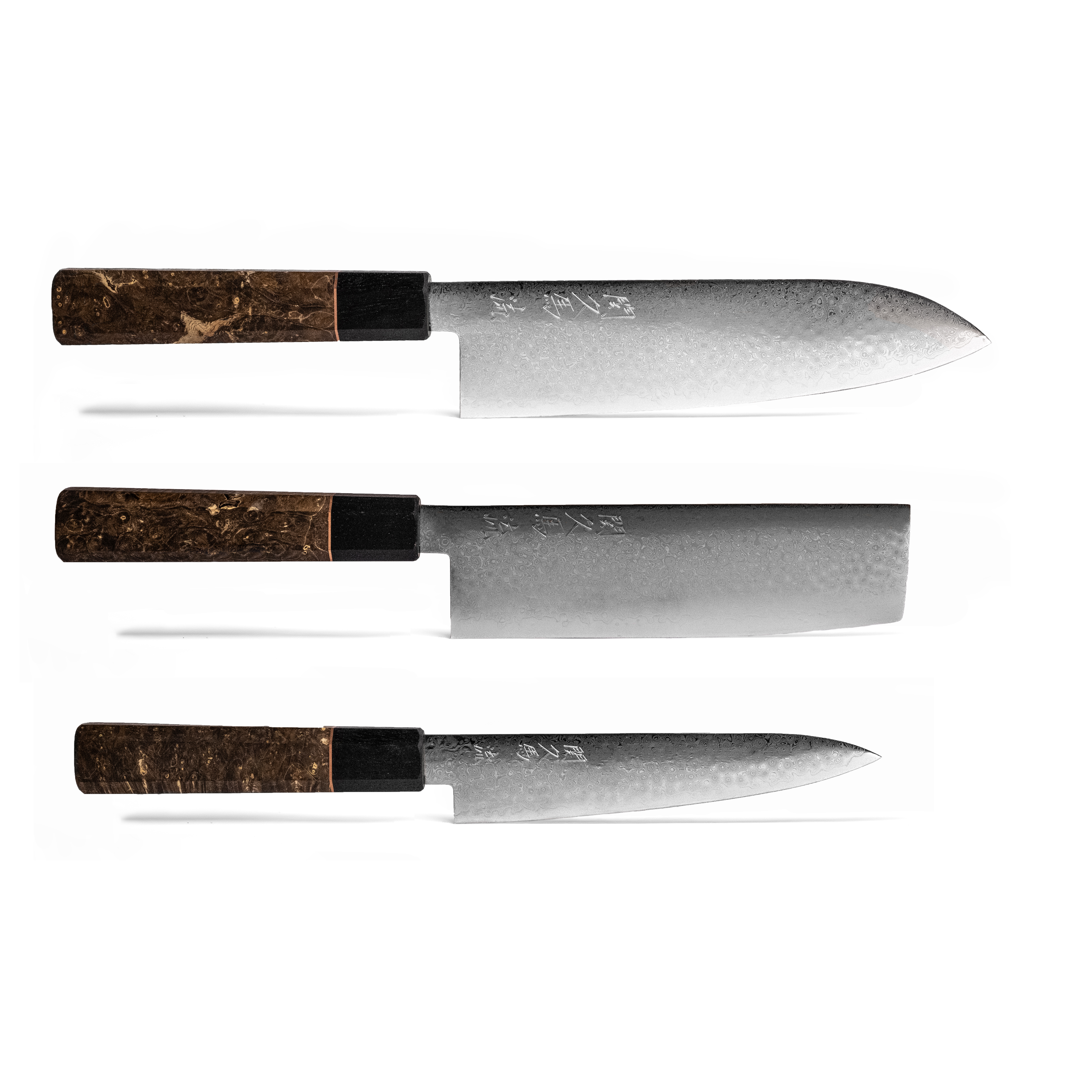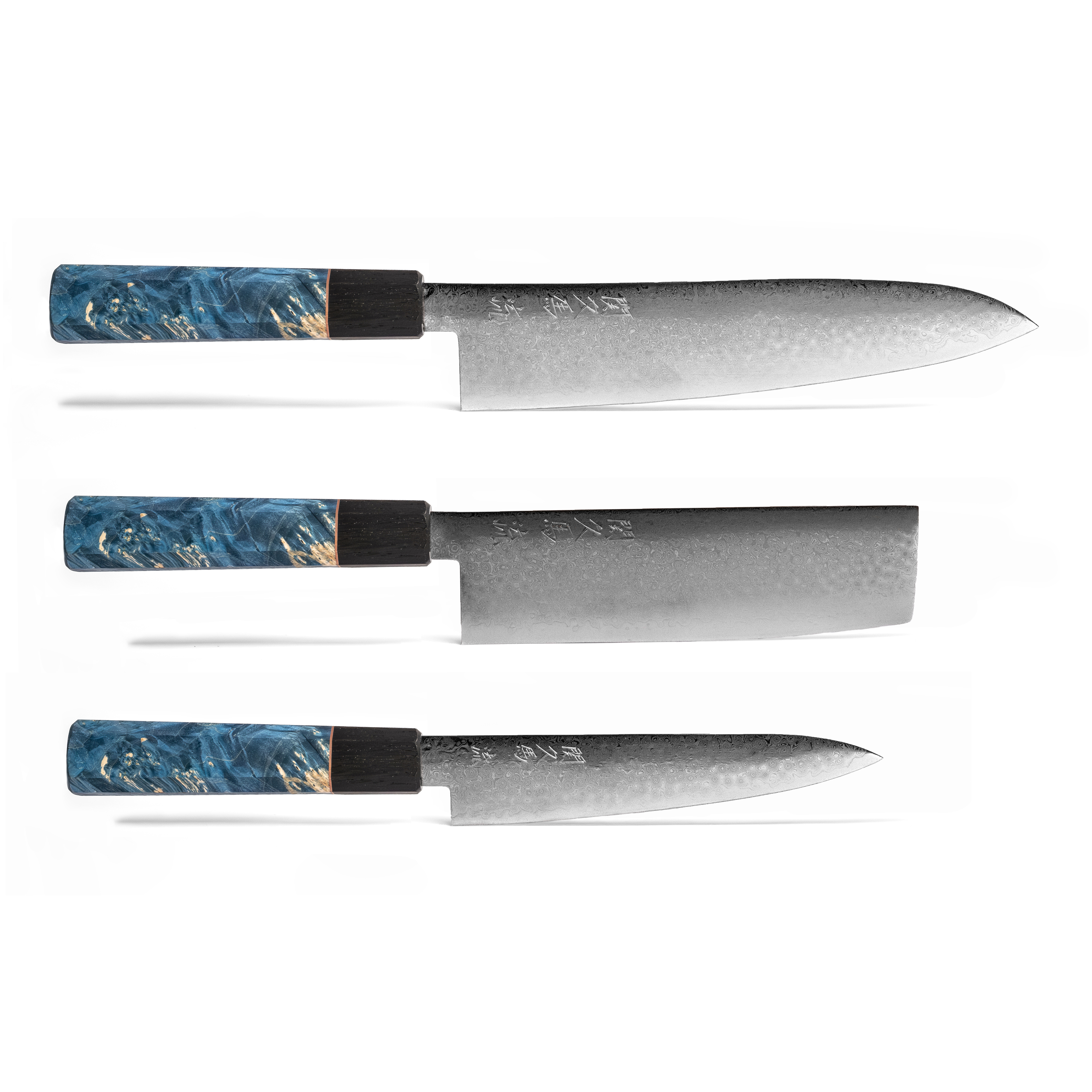For the culinary enthusiast seeking to elevate their home kitchen to professional-grade status, few purchases are more worthy of consideration than a premium, handcrafted Japanese kitchen knife. These blades represent the ultimate intersection of ultra-sharp performance, low-maintenance practicality, and generations of highly-refined metal- and blade-smithing traditions.
However, one of the key decisions faced when selecting a top-tier Japanese chef’s knife is whether to opt for a non-stainless, high-carbon steel blade or one crafted from a premium stainless steel alloy like VG10 or AUS10. Each brings its own set of advantages and considerations to the cutting board.
At Oishya, we’re proud to offer the very best examples of both stainless and carbon steel Japanese knives through our Sakai Kyuba and Seki Kyuba and Seki Kyuba Pro collections. Let’s explore the nuances of each type to help you make the most informed decision.
The Heritage of Carbon Steel Blades
For centuries, skilled Japanese blacksmiths have been revered for their ability to forge blades from simple, yet exceptional raw materials – namely high-carbon steel and iron. The resultant swords, knives, and tools demonstrated incredible cutting prowess while maintaining their coveted razor-sharp edges surprisingly well over time.

Much of this performance stems from the relatively simple, yet carefully manipulated makeup of traditional carbon steels used to make Japanese blades.
These “hagane” blade cores are formed by pounding together multiple layers of exceptionally pure iron and carbon materials using intricate folding techniques. The resulting ultra-dense, homogeneous steel can then be differentially hardened using expert quenching methods.
This allows carbon steel blades to attain incredible hardness ratings of 63-65 HRC on the Rockwell scale when done right. For reference, most premium western knives top out around 58-62 HRC. An edge honed on a metal this intensely hard can achieve untouchable sharpness and unmatched cutting performance right out of the gate. We’re talking laser-guided, split-a-falling-hair type precision that completely redefines what’s possible in the kitchen.
The tradeoff, however, is that these high-carbon steel knives are highly reactive to moisture and acidic foods. Their lack of the corrosion-resistant alloys present in stainless steel means they require meticulous care and maintenance. Any exposure to dampness or acids can rapidly cause staining, pitting, and edge deformities if not immediately dried and polished.
Herein lies the conundrum – do you prioritise a knife that offers the ultimate in sharpness and edge performance but requires the maintenance of an exotic sports car? Or would you favour a lower-maintenance but still incredibly capable blade that better suits a modern, busy home kitchen?
For those who deeply appreciate tradition and are willing to adopt a more ceremonial approach to caring for their fine kitchen cutlery, the non-stainless high-carbon steel knives simply can’t be beaten in terms of sharpness and sheer cutting prowess.
The Stainless Solution
On the other hand, premium stainless steel Japanese knives made from complex, modern alloys like VG10, AUS10, and powder metallurgy put ease-of-use and corrosion resistance at the forefront – perfect for home chefs who want a fine-edged, ultra-sharp blade with less upkeep.
Unlike their high-carbon cousins, these stainless blades incorporate a high percentage of chromium (usually 13-15%) as a key alloy element. It’s this chromium that allows a passive, protective oxidised layer to form across the metal’s surface in the presence of moisture and oxygen.
This ultra-thin chromium oxide coating creates an impenetrable barrier that makes the steel incredibly stain, rust, and corrosion-resistant compared to non-stainless versions. You can use and rinse them with confidence, and any splashes or residue wipes away with ease.
But stainless’ advantages go well beyond basic anti-corrosion properties. The intricate addition of other elements like molybdenum, vanadium, and carbon allow modern “super steels” like VG10 to approach (but not quite attain) the hardness levels and fine-edge capabilities of traditional carbon steel.
Our Seki Kyuba series, highlighted by knives with san mai construction and a VG10 stainless core, can achieve incredible 60-62 HRC hardness ratings. This allows their blades to take edges nearly as sharp as carbon steel, with drastically improved edge retention between re-sharpenings.
The ultra-premium Seki Kyuba Pro knives go one step further, incorporating hyper-hard R2/SG2 powder metallurgy touted for its elite-level sharpness, corrosion resistance, and overall performance. Yet they still require only basic, regular maintenance – no constant honing or polishing required.
For those who want knives that can approach the vaunted sharpness of traditional carbon steel with the amazing convenience, corrosion resistance, and ease of stainless, our Seki Kyuba (VG10) and Seki Kyuba Pro (R2/SG2) offerings are in a class by themselves.
Finding the Perfect Balance
At the end of the day, the ideal knife for your home kitchen depends on your priorities, preferences, and how much knife maintenance you’re willing to embrace.
If the utmost priority is attaining the absolute pinnacle of sharpness with traditional roots – and you consider caring for these blades a zen-like enjoyment rather than a chore – then a beautiful non-stainless, high-carbon steel knife is arguably the pinnacle cutting tool.
However, if you value incredible cutting performance from a stain-proof, corrosion-resistant blade that’s very low maintenance, then a premium stainless offering like our Sakai Kyuba AUS10 or Seki Kyuba VG10/R2 series delivers an elite combination of razor sharpness and daily practicality.
Bridging the Gap with Sakai Kyuba AUS10
That said, there is a “happy medium” series in our lineup that provides the best of both worlds – the Sakai Kyuba collection featuring AUS10 stainless steel blades.

While not capable of reaching the extreme initial sharpness levels of high-carbon or exotic “super steel” blades, AUS10 steel still enables Sakai Kyuba knives to take scalpel-sharp 60 HRC edges that far exceed most western knife steels in terms of cutting performance.
More importantly, the higher chromium content of AUS10 provides outstanding corrosion resistance and low-maintenance longevity compared to carbon steel. Your Sakai Kyuba slicers, vegetable knives, and more will hold their razor edges for months between basic honing while shaing off moisture and acids with ease. You get top-tier performance from a very practical, solid stainless steel.
And with their traditional Japanese wooden handles, nickel silver accents, and impeccable artisan craftsmanship by the legendary Sakai City bladesmiths, the Sakai Kyuba AUS10 knives represent a perfect bridge. They provide exceptional sharpness and edge retention complemented by all the time-honored aesthetics and heritage – but without the tedious maintenance requirements of carbon steel.
No matter which variety from non-stainless to semi-stainless to premium stainless you choose, our guiding philosophy at Oishya is to provide the very finest, most capable kitchen knives for home chefs of all skill and enthusiasm levels. We consider these blades specialised tools and works of functional art meant to inspire culinary confidence and enjoyment.
If you have any questions about finding the ideal knives for your needs, our team of experts is always here to help illuminate the nuances and guide you to the perfect addition for your kitchen arsenal. After all, the right knife in your hands is arguably the most important tool in any culinary pursuit.































